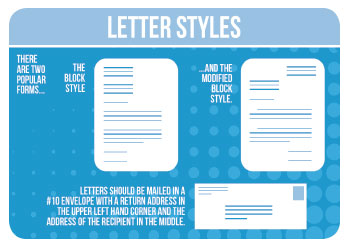
Effective Business Communications, Part Three
by Betsy Barbieux, CAM CFCAM / Published April 2015

The review so far of your effective business communications has included your professionalism, manners, dress (February FLCAJ), and grammar (March FLCAJ). Besides verbal communications, we also communicate via e-mail (blogs and websites) and paper letters, postcards, newsletters, etc. Let’s review the basics of e-mail and paper communications.
E -Mail Communications
Today, e-mail is the predominant method of written communication. When writing back and forth to friends and family, the causal format, spelling, grammar, etc., don’t matter much. But it is important to remember that your business e-mails should be just as well formatted as a letter written on paper. Just like a paper letter, e-mails need a return address, address, subject, salutation, body, complimentary closing, signature, and official title. Enclosures will be shown as attachments; copies to others will be shown as cc or bcc. Here are the basics of e-mail etiquette:
Before Sending E-mails
- Spell check—e-mails with typos are simply not taken as seriously.
- Read your e-mail out loud to ensure the tone is that which you desire.
- If you are angry, walk away from the e-mail for an hour or two, reread it, then delete it, or edit and send it.
- Think again before you “reply all.”
- When using auto fill, double check the address in the To: field to be sure it is the correct person/e-mail address.
- Always acknowledge receipt of an e-mail response. A “thank you” is sufficient.
- Be sure the Subject: field accurately reflects the content of your e-mail.
- Never expose your contact’s e-mail address to strangers by listing them all in the To: field. Use BCC.
- Think twice about forwarding an e-mail; then think a third time.
When Creating and Formatting E-mails
- Include a courteous greeting and closing.
- Address your contact with the appropriate level of formality, and make sure you spelled their name correctly.
- Keep e-mails brief and to the point.
- Do not type in all caps; it comes across as yelling.
- Use proper sentence structure. Use complete sentences. Avoid texting abbreviations. Capitalize the first word of each sentence and end with appropriate punctuation.
- Use formatting sparingly; an occasional bold or italics when appropriate is okay.
- If there is more than one item addressed in the e-mail, consider using bullet points to distinguish them.
- Include all relevant details or information necessary to understand your request or point of view.
- Use a plain background; no patterns or colors.
- Use a standard font; curvy fonts are too hard to read and not professional.
- Be sure to include the attachments; send the smallest size possible.
- When sending multiple attachments, send them in separate e-mails.
Other E-mail Considerations
- When there is a misunderstanding by e-mail, don’t hesitate to pick up the old-fashioned telephone to work things out!
- Think of your business e-mail as though it was on your business letterhead.
- If you cannot respond to an e-mail promptly, at the very least, e-mail back confirming your receipt and when the sender can expect your response.
- When replying to e-mails, always respond promptly and edit out unnecessary information from the post you are responding to.
- Formality is in place as a courtesy and reflects respect. Assume the highest level of formality with new e-mail contacts until the relationship dictates otherwise.
- Feel free to modify the subject field to more accurately reflect a conversation’s direction.
- Take the time to review each e-mail before clicking send to ensure your message is clear and you are relaying the tone that you desire.
- Start a new thread instead of using an old e-mail with an irrelevant subject line.
- Before getting upset because you perceive someone didn’t respond, check to see if their reply was inadvertently deleted or sent to your trash or junk folders.
- Take a quick look at the e-mails in your trash before you delete them just in case a good e-mail landed there by mistake.
 Paper Letters
Paper Letters
Even in today’s world, there is still the need to send an old-fashioned, paper letter. Though they can be generated using templates on your computer word processing programs, the professional must be aware of the required parts and the reasoning for the layout.
All letters (even e-mail letters) should have a standard structure containing seven parts:
- Heading
- Inside address
- Salutation
- Body
- Complimentary close
- Signature
- Signature identification and stenographic reference
The layout has three purposes:
- To make the message appealing in appearance and easy to read
- To draw attention to the important parts of the message
- To present the meaning clearly
Most managers would agree the number one pet peeve of e-mail communications (or paper letters) is the failure of the recipient to acknowledge receipt of it. It is especially aggravating to have someone request information or an opinion, you go through the time and trouble to research and respond with an answer, and then not receive even a “got it” or a “thank you.” Be sure to complete the circle of communication especially if you started the circle. It’s just good manners!

